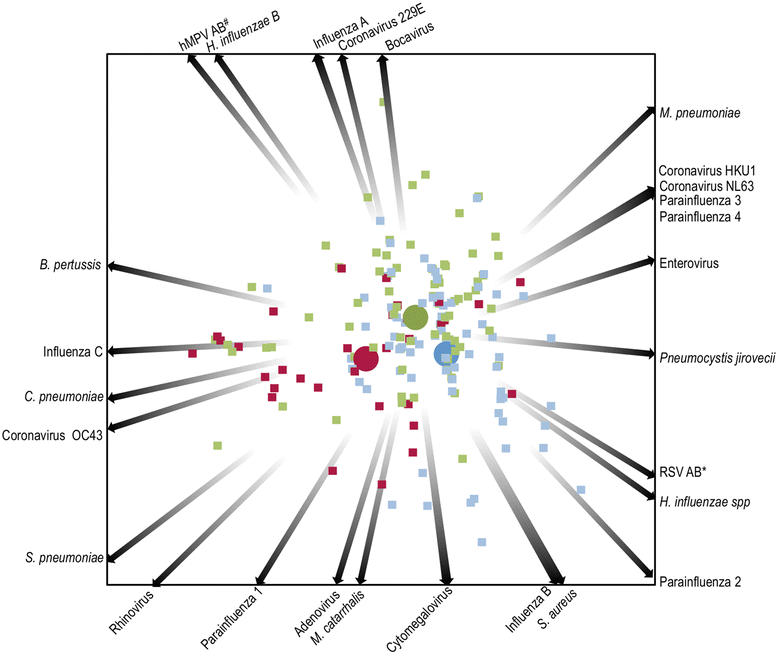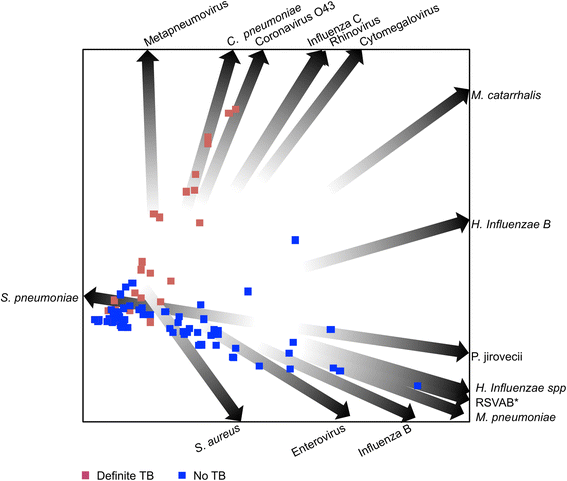Respiratory microbes present in the nasopharynx of children hospitalised with suspected pulmonary tuberculosis in Cape Town, South Africa
- PMID: 27776489
- PMCID: PMC5075757
- DOI: 10.1186/s12879-016-1934-z
Respiratory microbes present in the nasopharynx of children hospitalised with suspected pulmonary tuberculosis in Cape Town, South Africa
Abstract
Background: Lower respiratory tract infection in children is increasingly thought to be polymicrobial in origin. Children with symptoms suggestive of pulmonary tuberculosis (PTB) may have tuberculosis, other respiratory tract infections or co-infection with Mycobacterium tuberculosis and other pathogens. We aimed to identify the presence of potential respiratory pathogens in nasopharyngeal (NP) samples from children with suspected PTB.
Method: NP samples collected from consecutive children presenting with suspected PTB at Red Cross Children's Hospital (Cape Town, South Africa) were tested by multiplex real-time RT-PCR. Mycobacterial liquid culture and Xpert MTB/RIF was performed on 2 induced sputa obtained from each participant. Children were categorised as definite-TB (culture or qPCR [Xpert MTB/RIF] confirmed), unlikely-TB (improvement of symptoms without TB treatment on follow-up) and unconfirmed-TB (all other children).
Results: Amongst 214 children with a median age of 36 months (interquartile range, [IQR] 19-66 months), 34 (16 %) had definite-TB, 86 (40 %) had unconfirmed-TB and 94 (44 %) were classified as unlikely-TB. Moraxella catarrhalis (64 %), Streptococcus pneumoniae (42 %), Haemophilus influenzae spp (29 %) and Staphylococcus aureus (22 %) were the most common bacteria detected in NP samples. Other bacteria detected included Mycoplasma pneumoniae (9 %), Bordetella pertussis (7 %) and Chlamydophila pneumoniae (4 %). The most common viruses detected included metapneumovirus (19 %), rhinovirus (15 %), influenza virus C (9 %), adenovirus (7 %), cytomegalovirus (7 %) and coronavirus O43 (5.6 %). Both bacteria and viruses were detected in 73, 55 and 56 % of the definite, unconfirmed and unlikely-TB groups, respectively. There were no significant differences in the distribution of respiratory microbes between children with and without TB. Using quadratic discriminant analysis, human metapneumovirus, C. pneumoniae, coronavirus 043, influenza virus C virus, rhinovirus and cytomegalovirus best discriminated children with definite-TB from the other groups of children.
Conclusions: A broad range of potential respiratory pathogens was detected in children with suspected TB. There was no clear association between TB categorisation and detection of a specific pathogen. Further work is needed to explore potential pathogen interactions and their role in the pathogenesis of PTB.
Keywords: Infection; Microbiota; Mycobacterium tuberculosis; Nasopharynx; Respiratory microbes; Tuberculosis.
Figures


Similar articles
-
Rapid diagnosis of pulmonary tuberculosis in African children in a primary care setting by use of Xpert MTB/RIF on respiratory specimens: a prospective study.Lancet Glob Health. 2013 Aug;1(2):e97-e104. doi: 10.1016/S2214-109X(13)70036-6. Epub 2013 Jul 24. Lancet Glob Health. 2013. PMID: 25104164
-
Pathogen Clearance and New Respiratory Tract Infections Among Febrile Children in Zanzibar Investigated With Multitargeting Real-Time Polymerase Chain Reaction on Paired Nasopharyngeal Swab Samples.Pediatr Infect Dis J. 2018 Jul;37(7):643-648. doi: 10.1097/INF.0000000000001876. Pediatr Infect Dis J. 2018. PMID: 29889810
-
High burden of viral respiratory co-infections in a cohort of children with suspected pulmonary tuberculosis.BMC Infect Dis. 2020 Dec 4;20(1):924. doi: 10.1186/s12879-020-05653-9. BMC Infect Dis. 2020. PMID: 33276721 Free PMC article.
-
Understanding the interaction between cytomegalovirus and tuberculosis in children: The way forward.PLoS Pathog. 2021 Dec 9;17(12):e1010061. doi: 10.1371/journal.ppat.1010061. eCollection 2021 Dec. PLoS Pathog. 2021. PMID: 34882748 Free PMC article. Review.
-
Neuroimmune recognition and regulation in the respiratory system.Eur Respir Rev. 2024 Jun 26;33(172):240008. doi: 10.1183/16000617.0008-2024. Print 2024 Apr. Eur Respir Rev. 2024. PMID: 38925790 Free PMC article. Review.
Cited by
-
[Characteristics of pulmonary function in infants and young children with pertussis-like coughing].Zhongguo Dang Dai Er Ke Za Zhi. 2020 Aug;22(8):839-843. doi: 10.7499/j.issn.1008-8830.2004061. Zhongguo Dang Dai Er Ke Za Zhi. 2020. PMID: 32800030 Free PMC article. Chinese.
-
Identification of etiologic agents and clinical characteristics for patients suspected of having pertussis in a large Children's Hospital in China.Ann Transl Med. 2019 Sep;7(18):443. doi: 10.21037/atm.2019.08.85. Ann Transl Med. 2019. PMID: 31700879 Free PMC article.
-
Coronavirus infections: Epidemiological, clinical and immunological features and hypotheses.Cell Stress. 2020 Mar 2;4(4):66-75. doi: 10.15698/cst2020.04.216. Cell Stress. 2020. PMID: 32292881 Free PMC article.
-
Composition and variation of respiratory microbiota in healthy military personnel.PLoS One. 2017 Dec 7;12(12):e0188461. doi: 10.1371/journal.pone.0188461. eCollection 2017. PLoS One. 2017. PMID: 29216202 Free PMC article.
-
SARS-CoV-2: fear versus data.Int J Antimicrob Agents. 2020 May;55(5):105947. doi: 10.1016/j.ijantimicag.2020.105947. Epub 2020 Mar 19. Int J Antimicrob Agents. 2020. PMID: 32201354 Free PMC article.
References
-
- Zar HJ, Barnett W, Stadler A, Gardner-Lubbe S, Myer L, et al. Aetiology of childhood pneumonia in a well vaccinated South African birth cohort: a nested case-control study of the Drakenstein Child Health Study. Lancet Respir Med. 2016;4:463–72. doi: 10.1016/S2213-2600(16)00096-5. - DOI - PMC - PubMed
MeSH terms
Grants and funding
LinkOut - more resources
Full Text Sources
Other Literature Sources
Miscellaneous

